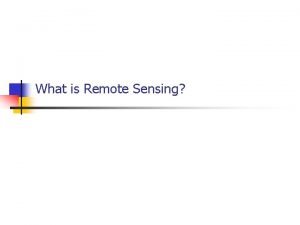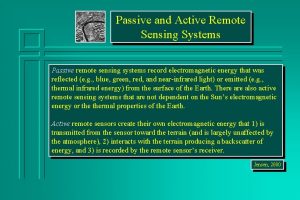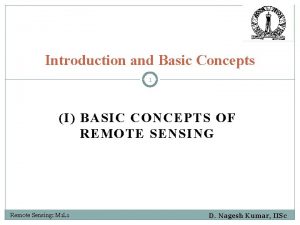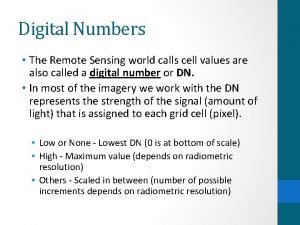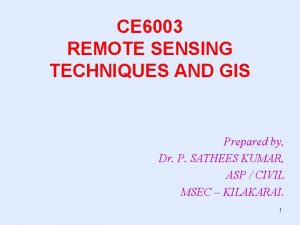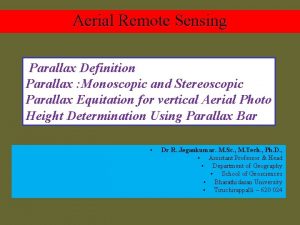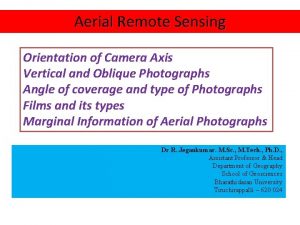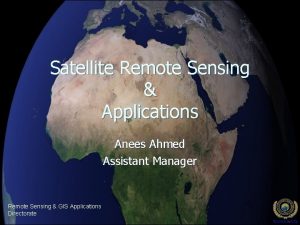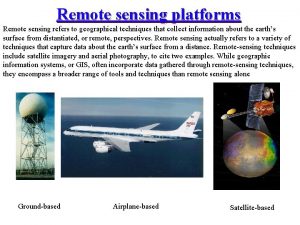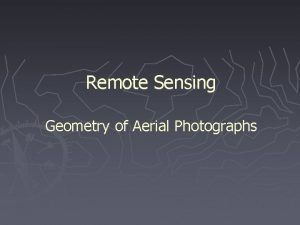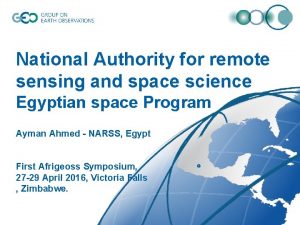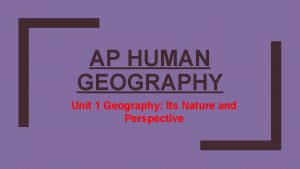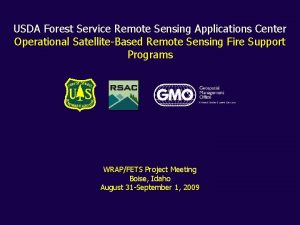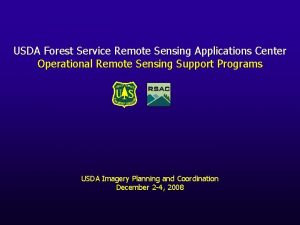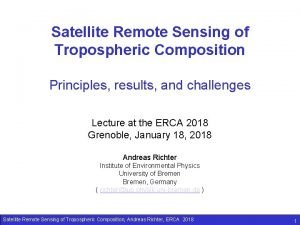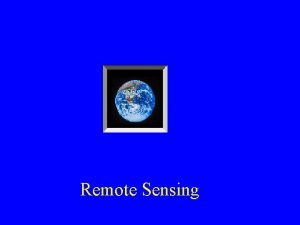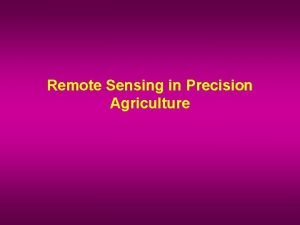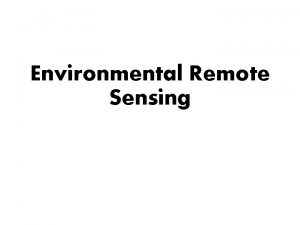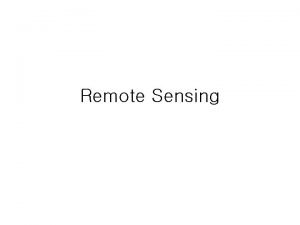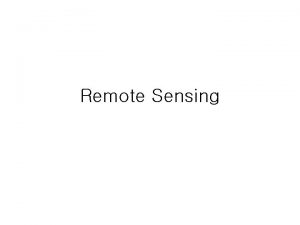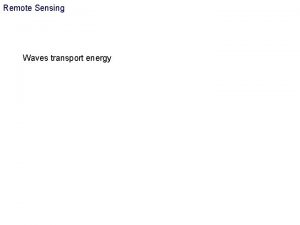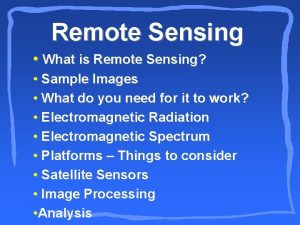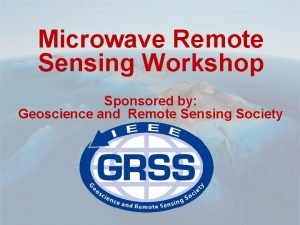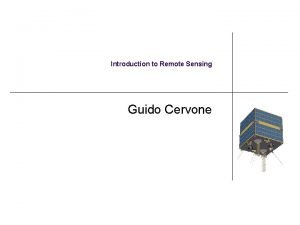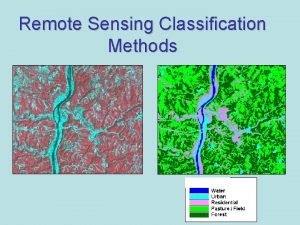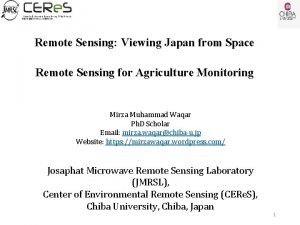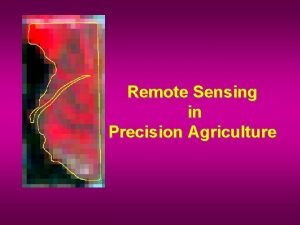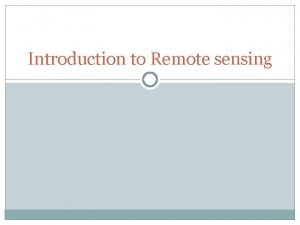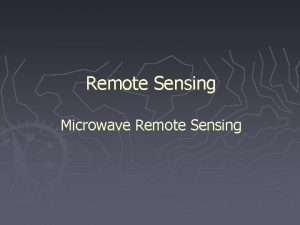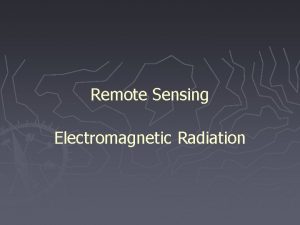Remote Sensing of Water Properties Using the SWIR






















- Slides: 22

Remote Sensing of Water Properties Using the SWIR -based Atmospheric Correction Algorithm Menghua Wang Wei Shi and Seung. Hyun Son NOAA/NESDIS/STAR E/RA 3, Room 102, 5200 Auth Road Camp Springs, MD 20746, USA Menghua. Wang@noaa. gov MODIS Science Team Meeting Marriott Inn/Conference Center, College Park, Maryland, May 18 -20, 2011 Acknowledgements Supports from NOAA/NASA funding, NASA Sea. BASS in situ data, in situ data from Lake Taihu (J. Tang and Y. Zhang), and MODIS Level 1 B data. Menghua Wang, NOAA/NESDIS/STAR

Atmospheric Correction: SWIR Bands (Wang & Shi, 2005; Wang, 2007) · · · At the shortwave infrared (SWIR) wavelengths (>~1000 nm), water has much stronger absorptions. Thus, atmospheric correction (Gordon & Wang, 1994) can be carried out for coastal regions with the black pixel assumption at the SWIR bands. Water absorption for 869 nm, 1240 nm, 1640 nm, and 2130 nm are 5 m-1, 88 m-1, 498 m-1, and 2200 m-1, respectively. MODIS has three SWIR bands at 1240, 1640, and 2130 nm, designed for atmosphere and land applications. Ø We use the SWIR band for the cloud masking. This is necessary for coastal region and inland lake waters. ü Require sufficient SNR characteristics for the SWIR bands and the SWIR atmospheric correction has slight larger noises at the short visible bands (compared with those from the NIR algorithm). Menghua Wang, NOAA/NESDIS/STAR 2

n. Lw(443) Scale: 0. -3. 0 (m. W/cm 2 m sr) July, 2005 NIR-SWIR Data Processing Chlorophyll-a 0. 01 -10 (mg/m 3) (Log scale) Wang, M. , S. Son, and W. Shi (2009), “Evaluation of MODIS SWIR and NIRSWIR atmospheric correction algorithms using Sea. BASS data, ” Remote Sens. Environ. , 113, 635 -644. Menghua Wang, NOAA/NESDIS/STARJuly, 2005 NIR-SWIR Data Processing

Menghua Wang, NOAA/NESDIS/STAR

Results from Inland Lake Taihu Using the SWIR algorithm, we have derived the water optical properties over the Lake Taihu using the MODIS-Aqua measurements during the spring of 2007 for monitoring a massive blue-green algae bloom, which was a major natural disaster affecting several millions residents in nearby Wuxi city. Wang, M. and W. Shi (2008), “Satellite observed algae blooms in China’s Lake Taihu”, Eos, Transaction, American Geophysical Union, 89, p 201 -202, May 27. Wang, M. , W. Shi, and J. Tang (2011), “Water property monitoring and assessment for China’s inland Lake Taihu from MODIS-Aqua measurements”, Remote Sens. Environ. , 115, 841 -854. Ø The work was featured in the NASA 2008 Sensing Our Planet (http: //nasadaacs. eos. nasa. gov/articles/2008_algae. html) Menghua Wang, NOAA/NESDIS/STAR 5

Geo-location of Lake Taihu Extremely Turbid Waters ü The third largest fresh inland lake in China (~2, 250 km 2). ü Located in one of the world’s most urbanized and heavily populated areas. ü Provide water resource for several million residents in nearby Wuxi city. Menghua Wang, NOAA/NESDIS/STAR

Methodology (1) Ø The SWIR atmospheric correction algorithm (Wang, 2007; Wang & Shi, 2005) is used for the water property data processing. Ø Since MODIS 1240 nm band is not always black for the entire Lake Taihu, we have developed three-step method in the data processing for each MODIS-Aqua data file: ü First, regions for the black of 1240 nm band are determined using the SWIR data processing. ü Second, a dominant aerosol model from the region with black of 1240 nm band is obtained, and ü Finally, with the derived aerosol model, the SWIR atmospheric correction algorithm is run using only 2130 nm band (with fixed aerosol model). Ø The Lake Taihu water property data are then derived. Wang, M. , W. Shi, J. Tang (2011), “Water property monitoring and assessment for China’s inland Lake Taihu from MODIS-Aqua measurement, ” Remote Sens. Environ. , 115, 841 -854. Menghua Wang, NOAA/NESDIS/STAR

Menghua Wang, NOAA/NESDIS/STAR (Wang and Shi, 2008)

Validation Results for MODIS-derived Water-leaving Radiance Spectra Menghua Wang, NOAA/NESDIS/STAR

Methodology (2) Ø Black pixel assumption at the SWIR 1640 and 2130 nm is generally valid for Lake Taihu. Ø The SWIR atmospheric correction algorithm using bands 1640 and 2130 nm (Wang, 2007) can be used for the water property data processing. Ø However, for MODIS-Aqua, four out of ten detectors for the SWIR 1640 nm band are inoperable (dysfunctional). Ø We focus on deriving seasonal results for the lake using the SWIR 1640 and 2130 nm atmospheric correction algorithm. Ø More in situ data (five seasonal cruises in 2006 -2007 in the lake) are also available to us now. Menghua Wang, NOAA/NESDIS/STAR

Validation Results for MODIS-derived Water-leaving Radiance Spectra Menghua Wang, NOAA/NESDIS/STAR

Validation Results in Lake Taihu (1) Menghua Wang, NOAA/NESDIS/STAR

Validation Results in Lake Taihu (2) Menghua Wang, NOAA/NESDIS/STAR

Validation Results in Lake Taihu (3) Menghua Wang, NOAA/NESDIS/STAR

Spatial Non-uniformity in Lake Taihu Menghua Wang, NOAA/NESDIS/STAR

Spring Summer Menghua Wang, NOAA/NESDIS/STAR Fall Winter

Seasonal Histograms in n. Lw(1240) TOA Radiance at 1240 nm ~0. 1 m. W cm-2 um-1 sr-1 Menghua Wang, NOAA/NESDIS/STAR

Climatology Histogram in n. Lw(1240) TOA Radiance at 1240 nm ~0. 1 m. W cm-2 um-1 sr-1 Menghua Wang, NOAA/NESDIS/STAR

Menghua Wang, NOAA/NESDIS/STAR

Conclusions Ø For the turbid waters in coastal regions and inland lakes, it has been demonstrated that the SWIR bands can be used for atmospheric correction. Ø Future ocean (water) color satellite sensor needs to include the SWIR bands with sufficient SNR values for cases with turbid waters. Menghua Wang, NOAA/NESDIS/STAR 20

Thank You! Menghua Wang, NOAA/NESDIS/STAR

Comparisons Between MODIS and In Situ (Sea. BASS) Data Menghua Wang, NOAA/NESDIS/STAR
 Richard “dick” marcinko,
Richard “dick” marcinko, Energy transfer
Energy transfer Remote sensing platforms
Remote sensing platforms Active passive remote sensing
Active passive remote sensing Limitations of remote sensing
Limitations of remote sensing Digital number in remote sensing
Digital number in remote sensing Limitations of remote sensing
Limitations of remote sensing Idealized remote sensing system
Idealized remote sensing system Gis definition ap human geography
Gis definition ap human geography Remote sensing ap human geo
Remote sensing ap human geo Monoscopic definition
Monoscopic definition Strip camera in remote sensing
Strip camera in remote sensing Remote sensing image
Remote sensing image Ifov and fov in remote sensing
Ifov and fov in remote sensing Geometry of aerial photography pdf
Geometry of aerial photography pdf National authority for remote sensing and space sciences
National authority for remote sensing and space sciences Canadian centre for remote sensing
Canadian centre for remote sensing Distortion definition ap human geography
Distortion definition ap human geography Remote sensing applications center
Remote sensing applications center Remote sensing applications center
Remote sensing applications center Remote sensing physics
Remote sensing physics Microwave remote sensing lecture notes
Microwave remote sensing lecture notes Remote sensing in precision agriculture
Remote sensing in precision agriculture

